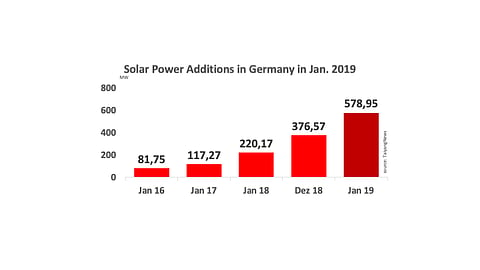

Starting the year 2019 with a bang, Germany's Federal Network Agency (Bundesnetzagentur) said the country installed over half a GW in the month of January 2019 itself with 578.959 MW.
The biggest contributor to this number were rooftop systems with 502.9 MW. Interestingly, only 52.3 MW of ground mounted PV were installed, out of which 23.67 MW came from projects of up to 750 kW non-tender capacity. A major reason for this hike seems to be an extraordinary and feed-in-tariff (FIT) cut for commercial and industrial systems of 40 to 750 kW that was surprisingly announced in November. The reduction is implemented in three phases starting in February 2019.
Moreover, 76 new tenant power plants (Mieterstrom-Systems) equal to 1.46 MW were registered, bringing the total for that segment to 434 projects and 9.47 MW.
In comparison the Jan 2019 installations, in the same month a year earlier PV additions totalled 220 MW, which back then was a good jump over the previous 2 years (see Germany Hits January PV High Of 220 MW). Even sequentially, the numbers were top; 376 MW of new capacity was installed in December 2018, taking the cumulative for the year 2018 to over 2.96 GW (see Germany Installed Close To 3 GW Solar In 2018).
The January 2019 additions take the country's cumulative solar power capacity installed to 46.5 GW, adding up 10.566 GW before 2010, and 35.9 GW added since 2010.
With solar installations meeting the 12 months target threshold, FITs are cut as of March. From March 1, 2019, FIT for system capacities of up to 10 kW will come down to €0.1123 per kWh, for 10 kW to 40 kW it will be €0.1092 per kWh and for those between 40 kW to 100 kW, it will be €0.0899 per kWh. For system ranges of between 40 kW to 750 kW, the FIT will be reduced to €0.0939 per kWh.
